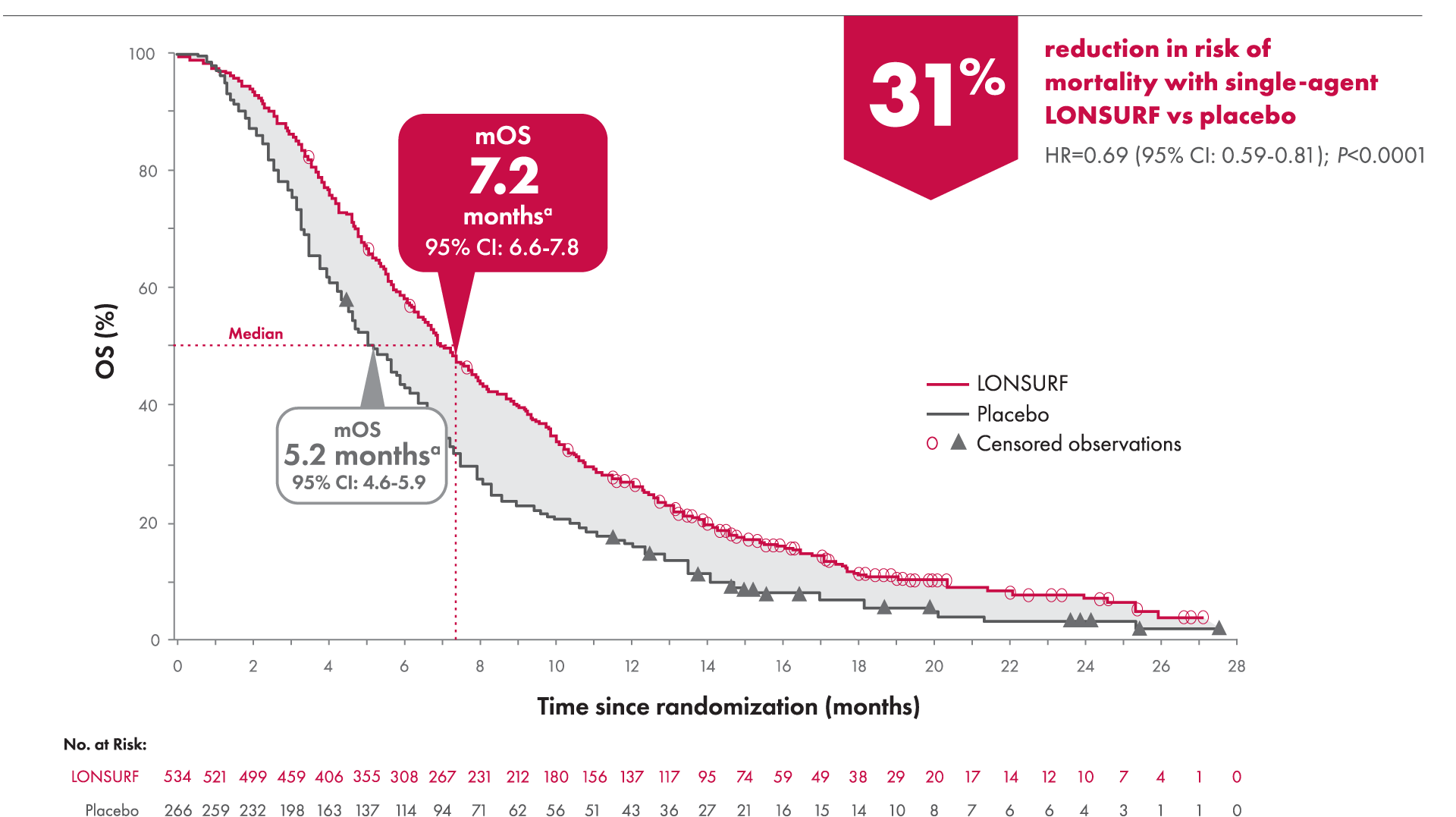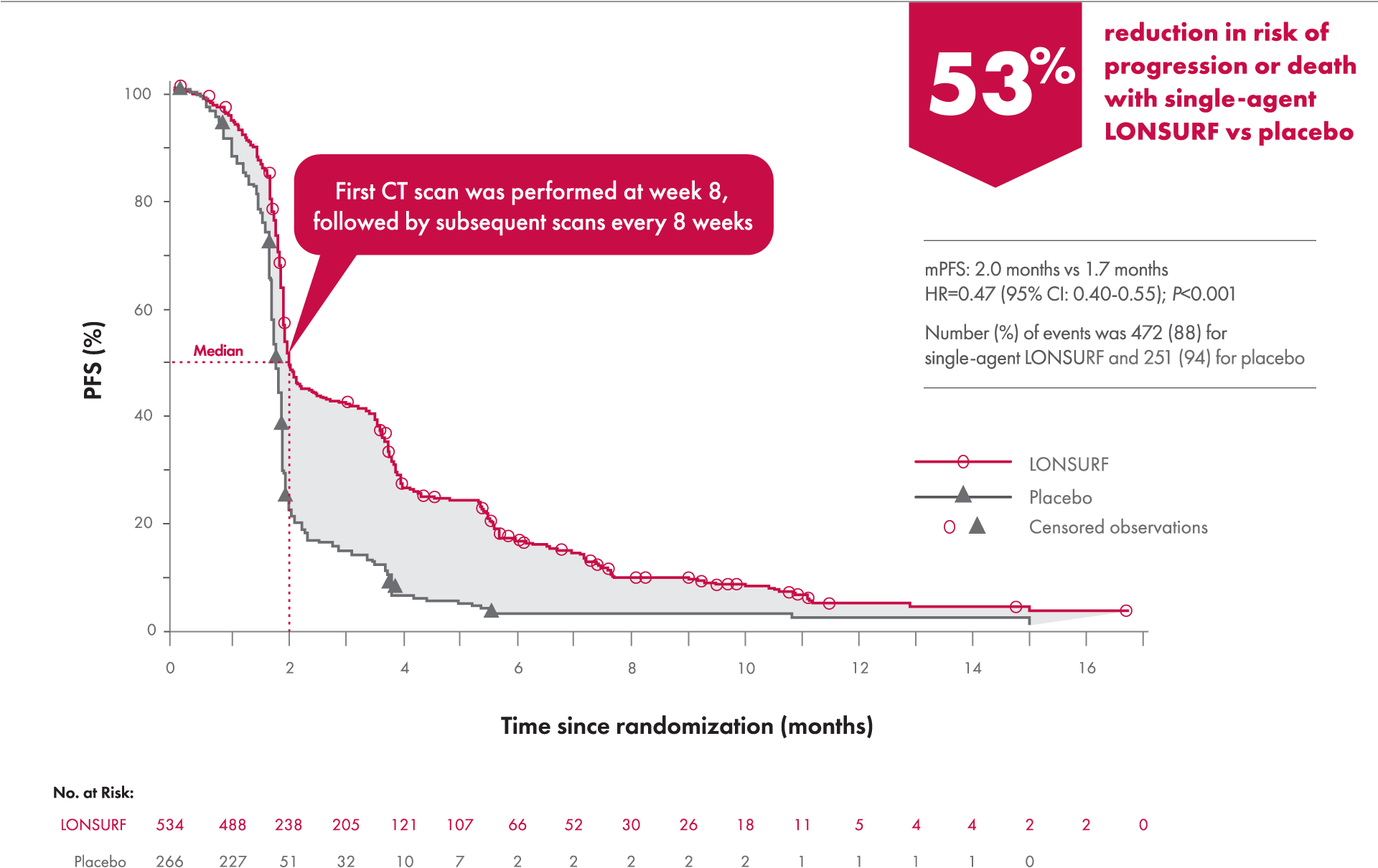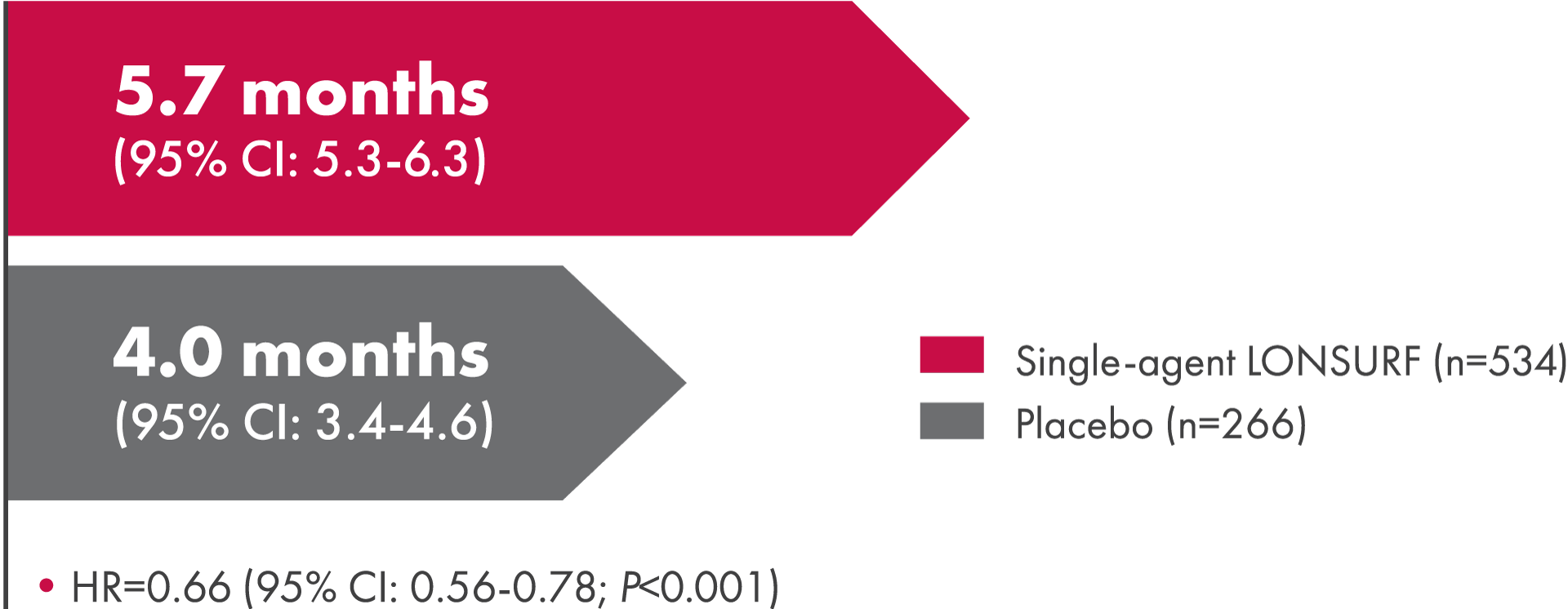Single-agent LONSURF for patients with previouslytreated mCRC
LONSURF was initially approved based on the RECOURSE trial1,2
mCRC=metastatic colorectal cancer.
On this page
RECOURSE was an international, randomized, double-blind, placebo-controlled, phase 3 clinical trial.1
Inclusion criteria1-3
- Age ≥18 years
- Confirmed adenocarcinoma of the colon or rectum
- ECOG performance status of 0 or 1
- Received at least 2 prior regimens of standard chemotherapy and were
refractory to or were failing all of the following within 3 months
- Fluoropyrimidine, irinotecan and oxaliplatin
- Anti-VEGF biological therapy
- Anti-EGFR therapy (if RAS wild-type)
- Disease progression based on imaging during or within 3 months of the last administration of each of the standard chemotherapies
2:1 Randomization1
LONSURF + BEST SUPPORTIVE CARE (n=534)
35 mg/m2 twice daily after meals for 5 days a week with 2 days rest for 2 weeks, followed by a 14-day rest, repeated every 4 weeks
Placebo + BEST SUPPORTIVE CARE (n=266)
Twice daily after meals for 5 days a week with 2 days rest for 2 weeks, followed by a 14-day rest, repeated every 4 weeks
All patients were followed for survival at scheduled 8 week intervals with computed tomography (CT) scans until 12 months after the first dose of study medication from the last patient randomized. After the end of treatment, all patients were followed for survival at scheduled 8 week time intervals until death.3
ECOG PS=Eastern Cooperative Oncology Group performance status.
Key baseline characteristics2
| Characteristic | LONSURF (n=534) | Placebo (n=266) | |
|---|---|---|---|
| Sex, n (%) | Male | 326 (61) | 165 (62) |
| Female | 208 (39) | 101 (38) | |
| Age (years) | Median | 63 | 63 |
| Range | 27-82 | 27-82 | |
| Race or ethnic group,a n (%) | White | 306 (57) | 155 (58) |
| Asian | 184 (34) | 94 (35) | |
| African American | 4 ( <1) | 5 (2) | |
| ECOG
performance status,b n (%) |
0 | 301 (56) | 147 (55) |
| 1 | 233 (44) | 119 (45) | |
| KRAS mutation, n (%) | No | 262 (49) | 131 (49) |
| Yes | 272 (51) | 135 (51) | |
| Time from diagnosis of metastases, n (%) | <18 months | 111 (21) | 55 (21) |
| ≥18 months | 423 (79) | 211 (79) | |
All patients received prior treatment with fluoropyrimidine-, oxaliplatin-, and irinotecan-based chemotherapy. All but one patient received bevacizumab, and all but two patients with KRAS wild-type tumors received panitumumab or cetuximab1
aRace was self-reported.
bEastern Cooperative Oncology Group (ECOG) performance status is scored on a scale of 0 to 5, with 0 indicating no symptoms, 1 indicating mild symptoms, and higher numbers indicating increasing degrees of disability.
OS with single-agent LONSURF
Primary endpoint: Overall Survival (OS) (N=800)2,4

OS was defined as the time (in months) from randomization until death.2
aKaplan-Meier estimates.1
CI=confidence interval; HR=hazard ratio; mOS=median overall survival.
PFS with single-agent LONSURF
Prespecified secondary endpoint: Progression-free Survival (PFS) (N=800)1-3

PFS was defined as the time (in months) from randomization to the first radiologic confirmation of disease progression or death from any cause.2
CT=computed tomography; mPFS=median progression-free survival.
Time to Worsening of ECOG PS
Additional secondary endpoint: Median time to worsening of ECOG PS to ≥22

- LONSURF provided a 34% reduction in risk of deterioration to ECOG PS ≥2 vs placebo2
ECOG PS=Eastern Cooperative Oncology Group performance status.
Additional results
Other secondary endpoint: Disease control rate2,3| LONSURF (n=502) % (n) | Placebo (n=258) % (n) | |
|---|---|---|
| DCRa | 44% (221) | 16% (42) |
| Complete response | 0% (0) | <1% (1) |
| Partial response | 2% (8) | 0% (0) |
| Stable disease | 42% (213) | 16% (41) |
DCR was defined as the proportion of patients with a complete response, a partial response, or stable disease.
aP<0.001.
DCR=disease control rate.
NCCN Guidelines® in metastatic colorectal cancer
NCCN
Recommended
The National Comprehensive Cancer Network® (NCCN®) recommend trifluridine and tipiracil (LONSURF) +/- bevacizumab as NCCN Category 2A recommended options for a potential third-line or subsequent treatment in mCRC patients. The trifluridine and tipiracil (LONSURF) + bevacizumab combination is preferred.5,6
Category 2A=based upon lower-level evidence, there is uniform NCCN consensus that the intervention is appropriate.
Referenced with permission from the NCCN Clinical Practice Guidelines in Oncology (NCCN Guidelines®) for Rectal Cancer V.1.2024. © National Comprehensive Cancer Network, Inc. 2024. All rights reserved. Accessed February 5, 2024. To view the most recent and complete version of the guideline, go online to NCCN.org.
Referenced with permission from the NCCN Clinical Practice Guidelines in Oncology (NCCN Guidelines®) for Colon Cancer V.1.2024. © National Comprehensive Cancer Network, Inc. 2024. All rights reserved. Accessed February 5, 2024. To view the most recent and complete version of the guideline, go online to NCCN.org.
NCCN makes no warranties of any kind whatsoever regarding their content, use or application and disclaims any responsibility for their application or use in any way.
NCCN=National Comprehensive Cancer Network.
References: 1. LONSURF [package insert]. Princeton, NJ: Taiho Oncology, Inc.; 2023. 2. Mayer RJ, Van Cutsem E, Falcone A, et al; RECOURSE Study Group. Randomized trial of TAS-102 for refractory metastatic colorectal cancer. N Engl J Med. 2015;372(20):1909-1919. 3. Data on file. Taiho Oncology, Inc., Princeton, NJ. 4. Van Cutsem E, Mayer RJ, Laurent S, et al; RECOURSE Study Group. The subgroups of the phase III RECOURSE trial of trifluridine/tipiracil (TAS-102) versus placebo with best supportive care in patients with metastatic colorectal cancer. Eur J Cancer. 2018;90:63-72. 5. Referenced with permission from the NCCN Clinical Practice Guidelines in Oncology (NCCN Guidelines®) for Colon Cancer V.1.2024. © National Comprehensive Cancer Network, Inc. 2024. All rights reserved. Accessed February 5, 2024. To view the most recent and complete version of the guideline, go online to NCCN.org. 6. Referenced with permission from the NCCN Clinical Practice Guidelines in Oncology (NCCN Guidelines®) for Rectal Cancer V.1.2024. © National Comprehensive Cancer Network, Inc. 2024. All rights reserved. Accessed February 5, 2024. To view the most recent and complete version of the guideline, go online to NCCN.org.
INDICATIONS
LONSURF is indicated as a single agent or in combination with bevacizumab for the treatment of adult patients with metastatic colorectal cancer previously treated with fluoropyrimidine‑, oxaliplatin‑ and irinotecan‑based chemotherapy, an anti‑VEGF biological therapy, and if RAS wild‑type, an anti‑EGFR therapy.
LONSURF is indicated for the treatment of adult patients with metastatic gastric or gastroesophageal junction adenocarcinoma previously treated with at least two prior lines of chemotherapy that included a fluoropyrimidine, a platinum, either a taxane or irinotecan, and if appropriate,


INDICATIONS
LONSURF is indicated as a single agent or in combination with bevacizumab for the treatment of adult patients with metastatic colorectal cancer previously treated with fluoropyrimidine‑, oxaliplatin‑ and irinotecan‑based chemotherapy, an anti‑VEGF biological therapy, and if RAS wild‑type, an anti‑EGFR therapy.
LONSURF is indicated for the treatment of adult patients with metastatic gastric or gastroesophageal junction adenocarcinoma previously treated with at least two prior lines of chemotherapy that included a fluoropyrimidine, a platinum, either a taxane or irinotecan, and if appropriate,
IMPORTANT SAFETY INFORMATION
WARNINGS AND PRECAUTIONS
Severe Myelosuppression: In the 1114 patients who received LONSURF as a single agent, LONSURF caused severe or life‑threatening myelosuppression (Grade 3‑4) consisting of neutropenia (38%), anemia (17%), thrombocytopenia (4%) and febrile neutropenia (3%). Three patients (0.3%) died due to neutropenic infection/sepsis; four other patients (0.5%) died due to septic shock. A total of 14% of patients received granulocyte‑colony stimulating factors. In the 246 patients who received LONSURF in combination with bevacizumab, LONSURF caused severe or life-threatening myelosuppression (Grade 3‑4) consisting of neutropenia (52%), anemia (5%), thrombocytopenia (4%) and febrile neutropenia (0.4%). One patient (0.4%) died due to abdominal sepsis and two other patients (0.8%) died due to septic shock. A total of 29% of patients received granulocyte-colony stimulating factors. Obtain complete blood counts prior to and on Day 15 of each cycle of LONSURF and more frequently as clinically indicated. Withhold LONSURF for severe myelosuppression and resume at the next lower dosage.
Embryo‑Fetal Toxicity: LONSURF can cause fetal harm when administered to a pregnant woman. Advise pregnant women of the potential risk to the fetus. Advise females of reproductive potential to use effective contraception during treatment and for at least 6 months after the final dose.
USE IN SPECIFIC POPULATIONS
Lactation: It is not known whether LONSURF or its metabolites are present in human milk. There are no data to assess the effects of LONSURF or its metabolites on the breastfed child or the effects on milk production. Because of the potential for serious adverse reactions in breastfed children, advise women not to breastfeed during treatment with LONSURF and for 1 day following the final dose.
Male Contraception: Because of the potential for genotoxicity, advise males with female partners of reproductive potential to use condoms during treatment with LONSURF and for at least 3 months after the final dose.
Geriatric Use: Patients 65 years of age or older who received LONSURF as a single agent had a higher incidence of the following hematologic laboratory abnormalities compared to patients younger than 65 years: Grade 3 or 4 neutropenia (46% vs 32%), Grade 3 anemia (20% vs 14%), and Grade 3 or 4 thrombocytopenia (6% vs 3%). Patients 65 years of age or older who received LONSURF in combination with bevacizumab had a higher incidence of the following hematologic laboratory abnormalities compared to patients younger than 65 years: Grade 3 or 4 neutropenia (60% vs 46%) and Grade 3 or 4 thrombocytopenia (5% vs 4%).
Renal Impairment: No adjustment to the starting dosage of LONSURF is recommended in patients with mild or moderate renal impairment (CLcr of 30 to 89 mL/min). Reduce the starting dose of LONSURF for patients with severe renal impairment (CLcr of 15 to 29 mL/min) to a recommended dosage of 20 mg/m2.
Hepatic Impairment: Do not initiate LONSURF in patients with baseline moderate or severe (total bilirubin > 1.5 times ULN and any AST) hepatic impairment. Patients with severe hepatic impairment (total bilirubin > 3 times ULN and any AST) were not studied. No adjustment to the starting dosage of LONSURF is recommended for patients with mild hepatic impairment.
ADVERSE REACTIONS
Serious adverse reactions occurred in 25% of patients. The most frequent serious adverse reactions (≥2%) were intestinal obstruction (2.8%), and COVID-19 (2%). Fatal adverse reactions occurred in 1.2% of patients who received LONSURF in combination with bevacizumab, including rectal fistula (0.4%), bowel perforation (0.4%) and atrial fibrillation (0.4%).
The most common adverse reactions or laboratory abnormalities (≥10% in incidence) in patients treated with single‑agent LONSURF at a rate that exceeds the rate in patients receiving placebo in mCRC: anemia (77% vs 33%), neutropenia (67% vs 0.8%), asthenia/fatigue (52% vs 35%), nausea (48% vs 24%), thrombocytopenia (42% vs 8%), decreased appetite (39% vs 29%), diarrhea (32% vs 12%), vomiting (28% vs 14%), abdominal pain (21% vs 19%), and pyrexia (19% vs 14%). In metastatic gastric cancer or gastroesophageal junction (GEJ): neutropenia (66% vs 4%), anemia (63% vs 38%), nausea (37% vs 32%), thrombocytopenia (34% vs 9%), decreased appetite (34% vs 31%), vomiting (25% vs 20%), infections (23% vs 16%) and diarrhea (23% vs 14%).
Pulmonary emboli occurred more frequently in LONSURF‑treated patients compared to placebo: in mCRC (2% vs 0%) and in metastatic gastric cancer and GEJ (3% vs 2%).
Interstitial lung disease (0.2%), including fatalities, has been reported in clinical studies and clinical practice settings in Asia.
The most common adverse reactions or laboratory abnormalities (≥20% in incidence) in patients treated with LONSURF in combination with bevacizumab vs LONSURF alone were neutropenia (80% vs 68%), anemia (68% vs 73%), thrombocytopenia (54% vs 29%), fatigue (45% vs 37%), nausea (37% vs 27%), increased aspartate aminotransferase (34% vs 28%), increased alanine aminotransferase (33% vs 23%), increased alkaline phosphate (31% vs 36%), decreased sodium (25% vs 20%), diarrhea (21% vs 19%), abdominal pain (20% vs 18%), and decreased appetite (20% vs 15%).
You are now leaving LONSURFHCP.com
Thank you for visiting. You will now be sent to a site not controlled by Taiho Oncology Inc. A link to a non‑Taiho Oncology site does not constitute an endorsement of the products or services offered by the site, and Taiho Oncology Inc. is not responsible for the content of any non‑Taiho Oncology site.
LONSURF® (trifluridine and tipiracil) tablets consist of a thymidine‑based nucleoside analog, trifluridine, and the thymidine phosphorylase inhibitor, tipiracil, at a molar ratio 1:0.5 (weight ratio, 1:0.471). Inclusion of tipiracil increases trifluridine exposure by inhibiting its metabolism by thymidine phosphorylase.
Following uptake into cancer cells, trifluridine, in its triphosphate form (FTD‑TP), is incorporated into the DNA, interferes with DNA function, and inhibits cell proliferation. No enzyme has been identified for the dephosphorylation of FTD‑TP, which may explain its incorporation into DNA.
Trifluridine/tipiracil demonstrated anti-tumor activity against KRAS wild type and mutant human colorectal cancer xenografts in mice.3

